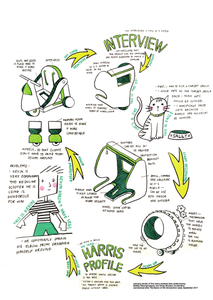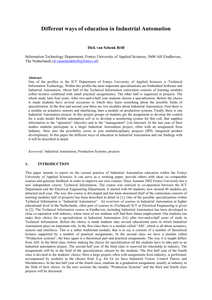A description of our experiences with a model for education in innovative, interdisciplinary and international engineering. (Students from different (technical) disciplines in Higher Education are placed in industry for a period of eighteen months after completing two-and-a-half year of theoretical studies). They work in multi-disciplinary projects on different themes, in order to grow to fully equal employees in industry. Besides students, teachers and company employees participate in the projects. The involvement of other level students, both from University and from Vocational Education, is recommended. The experiments in practice give confidence in the succesful implementation of this model.
DOCUMENT
The scope of technology has expanded towards areas such as sports and vitality, offering significant challenges for engineering designers. However, only little is known about the underlying design and engineering processes used within these fields. Therefore, this paper aims to get an indepth understanding of these type of processes. During a three-day design competition (Hackathon), three groups of engineers were challenged to develop experience-able prototypes in the field of sports and vitality. Their process was monitored based on the Reflective Transformative Design process (RTD-process) framework, describing the various activities part of the design process. Groups had to keep track of their activities, and six group reflection-sessions were held. Results show that all groups used an open and explorative approach, they frequently swapped between activities, making them able to reflect on their actions. While spending more time on envisioning and creating a clear vision seem to relate to the quality of the design concept.
DOCUMENT

Industrial Design Engineering [Open] Innovation (IDE) is a 3-year, English taught, VWO entry-level, undergraduate programme at The Hague University of Applied Sciences (THUAS). The IDE curriculum focuses on the fuzzy front end of (open) innovation, sustainable development, and impact in the implementation phase of product-service design. The work field of Industrial Design Engineering and Open Innovation, like many other domains, is growing increasingly more complex (Bogers, Zobel, Afuah, Almirall, Brunswicker, Dahlander, Frederiksen, Gawer, & Gruber, 2017). Not only have the roles of designers changed considerably in the last decades, they continue to do so at increasing speed. Therefore, industrial design engineering students need different and perhaps more competencies as young professionals in order to deal with this new complexity. Moreover, in our transitional society, lifelong learning takes a central position (Reekers, 2017). Students need to give their learning path direction autonomously, in accordance with their talents and interests. IDE’s Quality & Curriculum Committee (QCC) realized in 2015 there is too much new knowledge to address in a 3-year programme. Instead, IDE students need to learn how to become temporary experts in an array of topics, depending on the characteristics of each new project they do (see Textbox 1). The QCC also concluded that more than just incremental changes to the current curriculum were needed; thus, the idea for a flexible, choice-based semester approach in the curriculum was born: ‘Curriculum M’ (Modular). A co-creational approach was applied, in which teaching staff, students, alumni, prospective students, industry (including the (international) social profit sector), and educational advisors collaborated to develop a curriculum that would allow students to become not just T-shaped (wide basis, one expertise) professionals, but U- or W-shaped professionals, with strong links to other disciplines.
DOCUMENT

We found out that 25 % of our students came to study at the Electrical & Electronic Engineering department (E&E) because they were active (as a hobby) in music. Because of this the E&E department offers their students to work in video and audio themes in all projects of their education. From our inquiries we found out what students interests are and we use these interests for new project themes. The study has been changed in such a way that it is possible to have these project themes twice in every semester. Amongst them are, besides music, e.g. medical, sports, automotive and mechatronics. Other inquiries show that 47 % of our students choose for ICT because they are interested in computers or programming or do this for their hobby. Inspired by this the ICT department defined four new fields of interest: game design, management & security, mobile computing and life style. Both E&E and ICT connect the projects in their courses directly to industry and in this way students and lecturers are intensively involved in industry. From two surveys we learned that working this way is an excellent way to get students motivated and gives them drive and enjoyment in their study.
DOCUMENT

Deze publicatie richt zich vooral op het concept Design Based Research,gezien vanuit het perspectief van de bijna 40 lectoren die de hogeschool rijk is. Dit lectoratenoverzicht kan worden beschouwd als een atlas of reisgids waarmee de lezer een route kan afleggen langs de verschillende lectoraten. De lectoraten die actief zijn op het gebied van de Service Economy worden beschreven in hoofdstuk 2. De lectoraten die actief zijn op het gebied van Vitale Regio worden beschreven in hoofdstuk 3. De lectoraten die actief zijn op het gebied van Smart Sustainable Industries worden beschreven in hoofdstuk 4. De lectoraten die actief zijn op het gebied van de hogeschoolbrede thema’s Design Based Education en Research worden beschreven in hoofdstuk 5. Tenslotte wordt er in hoofdstuk 6 een eerste aanzet gedaan om één of meer verbindende thema’s of werkwijzen te ontdekken in de aanpak van de verschillende lectoraten. Het is niet de bedoeling van deze publicatie om een definitief antwoord te geven op de vraag wat NHL Stenden precies bedoelt met het concept Design Based Research. Het doel van deze publicatie is wel om een indruk te krijgen van wat er allemaal gebeurt binnnen de lectoraten van NHL Stenden, en om nieuwsgierig te worden naar meer.
DOCUMENT

This paper describes a model for education in innovative engineering. The kernel of this model is, that students from different departments of the faculty of Applied Science and Technology are placed in industry for a period of eighteen months after two-and-a-half year of theoretical studies. During this period students work in multi-disciplinary projects on different themes. Students will grow to fully equal employees in industry. Therefore it is important that besides students, teachers and company employees will participate in the projects. Also the involvement of other level students (University and high school) is recommended. The most important characteristics of the model can be summarized in innovative, interdisciplinary and international orientation.
DOCUMENT
The importance of teaching engineering students innovation development is commonly clearly understood. It is essential to achieve products which are attractive and profitable in the market. To achieve this, an institute of engineering education has to provide students with needed knowledge, skills and attitudes including both technical and business orientation. This is important especially for SME’s. Traditionally, education of engineering provides students with basic understanding how to solve common technical problems. However companies need wider view to achieve new products. Universities of applied Sciences in Oulu and Eindhoven want to research what is the today’s educational situation for this aim, to find criteria to improve the content of the educational system, and to improve the educational system. Important stakeholders are teachers and students within the institute but also key-persons in companies. The research is realized by questionnaires and interviews from which a current situation can be found. The research will also include the opinion of management who give possibilities to change the curriculum. By this research more insight will be presented about how to re-design a current curriculum. The research will act as basis for this discussion in SEFI-conference about formulating a curriculum that includes elements for wide-ranging knowledge and skills to achieve innovations especially in SME’s.
DOCUMENT
Within the profile Technical Information Technology (ICT Department) the most important specializations are Embedded Software and Industrial Automation. About half of the Technical Information curriculum consists of learning modules, the other half is organized in projects. The whole study lasts four years. After two-and-a-half year students choose a specialization. Before the choice is made students have several occasions in which they learn something about the possible fields of specialization. In the first and second year there are two modules about Industrial Automation. First there is a module on actuators, sensors and interfacing, later a module on production systems. Finally there is an Industrial Automation project. In this project groups of students get the assignment to develop the control for a scale model flexible automation cell or to develop a monitoring system for this cell. In the last year of their studies students participate in a larger Industrial Automation project, often with an assignment from Industry. Here also the possibility exists to join multidisciplinary projects (IPD; integrated product development).
DOCUMENT

This case study describes a special edition of the European Project Semester at the course Sustainable Packaging Design and Innovation at the Faculty of Industrial Design Engineering at The Hague University of Applied Sciences (Fall Semester 2017). In this special edition, unique cooperation took place between 12 parties. The parties were three research institutes, six universities, and three companies. Some parties have developed an educational module focused upon sustainable and circular packaging design, including the use of a dedicated tool for life cycle assessment. This module was embedded in the regular EPS. At The Hague University of Applied Sciences, an international class of 16 students worked in four teams on a real-life design assignment. They were offered a wide range of lectures, workshops, pitches, and presentations. The chapter concludes with a review of the followed processes and organizational, managerial, and practical concerns. Although run as a unique edition, all parties discuss to continue this cooperation.
DOCUMENT

Author supplied from the article: ABSTRACT Increasing global competition in manufacturing technology puts pressure on lead times for product design and production engineering. By the application of effective methods for systems engineering (engineering design), the development risks can be addressed in a structured manner to minimise chances of delay and guarantee timely market introduction. Concurrent design has proven to be effective in markets for high tech systems; the product and its manufacturing means are simultaneously developed starting at the product definition. Unfortunately, not many systems engineering methodologies do support development well in the early stage of the project where proof of concept is still under investigation. The number of practically applicable tools in this stage is even worse. Industry could use a systems engineering method that combines a structured risk approach, concurrent development, and especially enables application in the early stage of product and equipment design. The belief is that Axiomatic Design can provide with a solid foundation for this need. This paper proposes a ‘Constituent Roadmap of Product Design’, based on the axiomatic design methodology. It offers easy access to a broad range of users, experienced and inexperienced. First, it has the ability to evaluate if knowledge application to a design is relevant and complete. Secondly, it offers more detail within the satisfaction interval of the independence axiom. The constituent roadmap is based on recent work that discloses an analysis on information in axiomatic design. The analysis enables better differentiation on project progression in the conceptual stage of design. The constituent roadmap integrates axiomatic design and the methods that harmonise with it. Hence, it does not jeopardise the effectiveness of the methodology. An important feature is the check matrix, a low threshold interface that unlocks the methodology to a larger audience. (Source - PDF presented at ASME IMECE (International Mechanical Engineering Congress and Exposition
DOCUMENT
